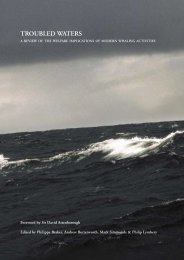The Case against Marine Mammals in Captivity - The Humane ...
The Case against Marine Mammals in Captivity - The Humane ...
The Case against Marine Mammals in Captivity - The Humane ...
- No tags were found...
Create successful ePaper yourself
Turn your PDF publications into a flip-book with our unique Google optimized e-Paper software.
OverviewIn the debate over mar<strong>in</strong>e mammals <strong>in</strong> captivity, thepublic display <strong>in</strong>dustry ma<strong>in</strong>ta<strong>in</strong>s that mar<strong>in</strong>e mammalexhibits serve a valuable conservation function, peoplelearn important <strong>in</strong>formation from see<strong>in</strong>g live animals, andcaptive mar<strong>in</strong>e mammals live a good life. However, animalprotection groups and a grow<strong>in</strong>g number of scientistscounter that the lives of captive mar<strong>in</strong>e mammals areimpoverished, people do not receive an accurate pictureof a species from captive representatives, and the trade <strong>in</strong>live mar<strong>in</strong>e mammals negatively impacts populations andhabitats. <strong>The</strong> more we learn of mar<strong>in</strong>e mammals, the moreevidence there is that the latter views are correct.<strong>The</strong> public display <strong>in</strong>dustry has asserted for many years that thedisplay of mar<strong>in</strong>e mammals serves a necessary educational purpose,for which the animals’ welfare need not be compromised.Mostly, this assertion has gone unchallenged. But as news gets outabout traumatic captures, barren concrete tanks, high mortalityrates, and aberrant—even dangerous—animal behavior, peopleare chang<strong>in</strong>g the way they “see” animals <strong>in</strong> captivity.of the natural environment. <strong>The</strong> truth is that mar<strong>in</strong>e mammalshave evolved physically and behaviorally to survive these rigors.For example, nearly every k<strong>in</strong>d of mar<strong>in</strong>e mammal, from sea lionto dolph<strong>in</strong>, travels large distances daily <strong>in</strong> a search for food. Incaptivity, natural feed<strong>in</strong>g and forag<strong>in</strong>g patterns are completelylost. Stress-related conditions such as ulcers, stereotypical behaviors<strong>in</strong>clud<strong>in</strong>g pac<strong>in</strong>g and self-mutilation, and abnormal aggressionwith<strong>in</strong> groups frequently develop <strong>in</strong> predators denied theopportunity to hunt. Other natural behaviors, such as those associatedwith dom<strong>in</strong>ance, mat<strong>in</strong>g, and maternal care, are altered <strong>in</strong>captivity, which can have a substantial impact on the animals.Wild-caught mar<strong>in</strong>e mammals gradually experience the atrophyof many of their natural behaviors and are cut off from the conditionsthat allow the expression of cultural traits such as specializedvocalizations and unique forag<strong>in</strong>g techniques. View<strong>in</strong>g captiveanimals gives the public a false picture of the animals’ naturallives. Worse yet, it desensitizes people to captivity’s <strong>in</strong>herentcruelties—for so many captive mar<strong>in</strong>e mammals, the world isa t<strong>in</strong>y enclosure, and life is devoid of naturalness.Some facilities promote themselves as conservation enterprises;however, few such facilities are <strong>in</strong>volved <strong>in</strong> substantial conservationefforts. Rather than enhanc<strong>in</strong>g wild populations, facilities engaged<strong>in</strong> captive breed<strong>in</strong>g tend merely to create a surplus of animals whomay never be released <strong>in</strong>to the wild and are therefore only usedto propagate the <strong>in</strong>dustry.Contrary to popular perception, captures of wild mar<strong>in</strong>e mammalsare not a th<strong>in</strong>g of the past. Live captures, particularly of dolph<strong>in</strong>s,cont<strong>in</strong>ue around the world <strong>in</strong> regions where very little is knownabout the status of populations. For smaller stocks, live captureoperations are a significant conservation concern. Even for thosestocks not currently under threat, the lack of scientific assessmentor regard for welfare makes the proliferation of these operationsan issue of global concern.<strong>The</strong> public display <strong>in</strong>dustry ma<strong>in</strong>ta<strong>in</strong>s that it enhances the lives ofmar<strong>in</strong>e mammals <strong>in</strong> captivity by protect<strong>in</strong>g them from the rigorsChildren learn to view dolph<strong>in</strong>s as dependent on humans—rather than as competent and <strong>in</strong>dependent—when their onlyexposure to these animals is <strong>in</strong> captivity. Photo:©iStockphoto.com/Zak Brown
















